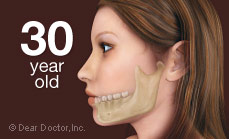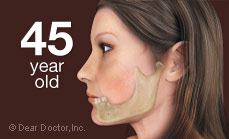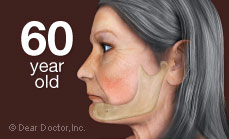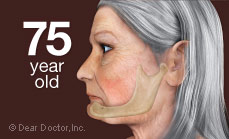Oral Dentistry
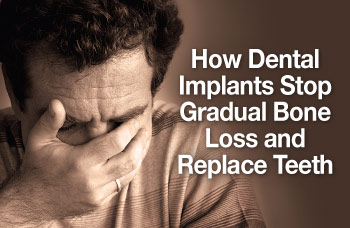
The goal of modern dentistry is to restore normal function, comfort, aesthetics, speech, and health to individuals who are missing teeth. Given that our population is both aging and growing, an increasing number of people are being affected by the loss of teeth. However, the more teeth a person is missing, the more challenging this task can become. As a result of continued research in the development of diagnostic tools and innovative treatment, predictable success is now a reality in many challenging dental situations. This is a blessing, because tooth loss has some serious consequences — particularly for older people, who are more likely to be missing teeth.
The Unseen Effects of Tooth Loss
The most obvious effect of missing teeth is aesthetic. The way you look affects the way you feel, and the psychological and social consequences of tooth loss can also be profound, as we shall see. But it's not just about unsightly gaps; there's something less apparent going on in the area of a lost tooth that can affect function, health, facial aesthetics — just about everything.
Believe it or not, in the beginning and at the end — it's not so much about teeth as it is about bone, which needs stimulation to maintain its form and density. In the case of alveolar (sac-like) bone which surrounds and supports teeth, the necessary stimulation comes from the teeth themselves. Teeth make hundreds of fleeting contacts with each other throughout the day. These small stresses are transmitted through the periodontal ligament (“peri” – around; “odont” – tooth) that suspends each tooth in its socket, prompting the bone to remodel and rebuild continually.
When a tooth is lost, the lack of stimulation causes loss of alveolar bone — its external width, then height, and ultimately bone volume. There is a 25% decrease in width of bone during the first year after tooth loss and an overall 4 millimeters decrease in height over the next few years.
As bone loses width, it loses height, then width and height again, and gum tissue also gradually decreases. Ability to chew and to speak can be impaired. The more teeth lost, the more function is lost. This leads to some particularly serious aesthetic and functional problems, particularly in completely edentulous (toothless) people.
And it doesn't stop there. After alveolar bone is lost, the bone beneath it, basal bone — the jawbone proper — also begins to resorb (melt away). The distance from nose to chin decreases and with it, the lower third of the face partially collapses. The chin rotates forward and upward, and the cheeks, having lost tooth support, become hollow. Extreme loss of bone can also make an individual more prone to jaw fractures as its volume depletes more and more.
So-called bite collapse can occur when only some of the back teeth, which support the height (vertical dimension) of the face, are missing. This can cause the front teeth to be squashed or pushed forward. They were not designed to support facial height or to chew food — only to hold and incise or tear it. Toothless people appear unhappy when their mouths are at rest because their lips, too, have sagged; unsupported by teeth and gum tissues they just cave in. Without teeth present, the tongue spreads into the space and the face collapses. The same is true of self-confidence.
The First Teeth To Go
In the United States, 70% of the population is missing at least one tooth, usually a back tooth. The first, or “6-year molars” are the first permanent (adult) teeth to erupt into the mouth and, unfortunately, are often the first teeth to be lost — as a result of decay, failed endodontic (root canal) therapy or fracture. In addition, they often have one or more crowns, which are still susceptible to recurrent decay. Longevity reports for crowns vary widely. The mean life span at failure of a crown has been reported as 10.3 years. Other reports range from a 3% failure rate at 23 years to a 20% failure rate at 30 years. Ultimately heavily restored and root canal treated teeth fail to recurrent decay, infection, structural failure or fracture. These teeth are at risk for extraction as a result of these complications, which are the leading causes of single posterior (back) tooth loss in adults.
 |
| Research has shown that while a natural tooth fixed bridge may replace a missing tooth, the teeth used to support the bridge are more susceptible to tooth decay, root canal problems, and gum disease. |
Up until now, the most common — but not necessarily the best — option for replacing a single back tooth has been a three-unit fixed partial denture (FPD), also called a fixed bridge. In this case, the two teeth on either side of the gap, known as abutment teeth, are crowned and the two crowns together support a “pontic” — a false tooth in the middle (from the French word for bridge). This type of prosthesis (false replacement) can be fabricated within one to two weeks and provides normal shape, function (eating, talking and smiling), comfort, aesthetics and health. Because of these benefits, FPDs have been the treatment of choice for the last six decades. Every dentist is familiar with how and when to use them; they are widely accepted by the profession, the public, and dental insurance companies.
FPDs are not invariably successful over time. If not well maintained, the pontics can act as reservoirs for bacterial biofilm and the abutment teeth can decay. As a result, the supporting abutment teeth are susceptible to structural failure from decay, failed endodontic therapy and/or fracture, increasing their risk of loss.
The abutment teeth of FPDs may be lost at rates as high as 30% within 14 years. Such unfavorable outcomes of FPD failure include the need to replace them and the loss of an abutment tooth or teeth.
According to the U.S. Administration on Aging, the population of Americans older than 65 years is expected to double to about 71 million by 2040. What’s more, the population of Americans older than 85 years is expected to increase to 9.6 million by 2030.
The unique dental needs and challenges of senior adults, includes a vital connection between a healthy body and a healthy mouth. If you want to feel good, stay healthy, and look great throughout life, you might be surprised what a difference a healthy mouth makes. By adopting healthy oral habits at home, making smart choices about diet and lifestyle, and seeking regular dental care, you can help your teeth last a lifetime.
As you know, your teeth are important for speaking, smiling, chewing and appearance. With regular dental visits and overall healthy habits, you can take control of your oral health—whether you have your natural teeth, implants or wear dentures. For more information, please read Tips for Taking Care of Your Teeth and Visiting the Dentist. You may also wish to review Frequently Asked Questions (PDF) that address popular topics such as brushing your teeth, oral cancer detection, oral effects of common medications, and more.
Ingenuity At Its Best
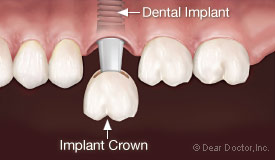 |
| An implant (and crown) not only look very natural, but also reduce stress on the remaining teeth by increasing bite support, improving chewing efficiency, and preventing shifting of the remaining teeth. |
What can be done to replace missing teeth and avoid debilitating bone loss? That depends on how many teeth have been lost. A better treatment option to replace a single missing back tooth is a single-tooth implant. A dental implant is actually a tooth root replacement, to which a crown is attached. The implant, made of commercially pure titanium, has a uniquely biocompatible property, which allows it to “osseointegrate” with the jawbone (“osseo” – bone; “integration” – fuse with). A crown, the portion of a tooth seen in the mouth, attaches to the implant, which looks, feels and functions like a natural tooth. And better yet, if for any reason the crown needs to be removed or replaced, it is removable, so that the implant is not compromised or damaged. Now that's ingenious.
For years, patients were advised to accept the limitations of a FPD as it was the best treatment for tooth replacement. The primary reasons for suggesting a fixed bridge were its clinical ease, reduced cost and treatment time. However, if this concept were expanded, extractions would replace root canals and removable partial dentures would be used instead of fixed bridgework. But the primary reason to suggest a particular treatment should not be related to time, costs or difficulty of the procedure; it should be the best possible long-term solution for each individual.
In 2008, my research colleagues and I surveyed more than 1,200 implants placed over a 10-year period. We found that over 99% of the implants were successful and functional. As important, survival of the adjacent teeth was not compromised. In comparison, FPD failure rates were as high as 20% within 3 years, and 50% rates at 10 years. The single-tooth implant represents the treatment of choice from both a health and value standpoint.
Health-related advantages of a dental implant tooth replacement include no risk of decay and decreased risk of periodontal (gum) disease. There is also a decreased risk of abutment tooth decay, endodontic (root canal) failure, and improved aesthetics since the adjacent teeth remain un-capped. Psychological advantages are significant as well, especially with congenitally missing teeth (“con” – without or missing, “genital” – birth).
Moreover, a single-tooth implant compared to a bridge becomes more advantageous financially over time. Although a single-tooth implant may be a little more expensive initially, survival time is greater making the implant option more cost-effective.
Replacing Multiple Teeth
Implants can also benefit those missing some or all of their teeth — and the number of these individuals is growing. A 1999-2002 survey found that Americans older than age 60 have lost an average of 9 teeth. Incredibly, approximately 30 million Americans or about 17% of the entire United States adult population had at least one full arch of teeth missing. Although the rate is decreasing every decade, the elderly population is rising so rapidly that the number of adults in need of one or two complete dentures is actually predicted to increase from 33.6 million adults in 1991 to 37.9 million adults in 2020.
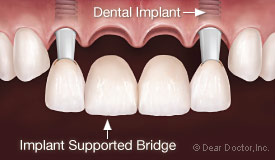 |
| An implant bridge can create a beautiful smile and restore function. Research reveals this is the most economical way to replace missing teeth over time. |
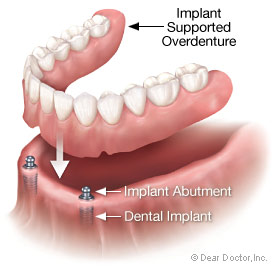
For these individuals, implants offer many advantages. They can be used to support bridges without the need for abutment teeth, or even a full arch of false teeth that would otherwise rely on support from pressure on the gums and underlying bone, which continues to resorb and melt away. A removable denture (complete or partial) pressing on the gum and oral membranes accelerates bone loss. Biting force is transferred to the bone surface only, not the bone structure. As a result, blood supply is reduced and total bone-volume loss occurs. This issue, which is of utmost importance, has been observed but not addressed in the past by traditional dentistry. In fact, denture-wearers are not always made aware that bone loss will cause their dentures to slip, and bone loss accelerates when dentures fit poorly. Implants prevent more than a twentyfold decrease in alveolar and jaw-bone loss, compared with removable dentures. Furthermore dentures may reduce function to one-sixth of the level formerly experienced with natural teeth, whereas implants may return function to near normal limits.
A fixed bridge or even a removable partial denture secured in place by implants is much more stable than a denture that relies only on the soft tissues of the mouth for support. Removable dentures (unsupported by implants) affect a person's ability to chew. Studies show that 29% of denture wearers are able to eat only soft or mashed foods, 50% avoid many foods and 17% claim they eat more efficiently without their dentures. Those who wear removable dentures tend to avoid fruits and vegetables. This can lead to poor nutrition, digestive tract problems, illness and even shortened life expectancy.
How Implants Stop Bone Loss
Dental implants fused and integrated into the jaw-bone serve both as anchors to support teeth and as one of the better preventive maintenance procedures in dentistry. A primary reason to consider dental implants to replace missing teeth is the maintenance of jaw bone. As you may recall, bone needs stimulation to stay healthy. An implant-supported tooth, or teeth, allow for normal function of the whole stomato-gnathic system (“stomato” – mouth; “gnathic” – jaws) including the nerves, muscles and jaw joints. Moreover dental implants fuse to the bone, stabilizing and stimulating it to maintain its dimension and density.
In addition implant-supported fixed bridges function the same as natural teeth. Beneficial effects of improved diet have been reported, as well as significant improvement in eating enjoyment and social life. And those with dental implant tooth replacements judge their overall psychological health improved by 80% compared with their previous state while wearing traditional, removable dentures. In fact, they reported feeling that their implants were an integral part of their body.
The success rate of dental implant prostheses (tooth replacements) varies, depending on a host of factors that change for each individual. However, compared with traditional methods, they offer increased longevity, improved function, bone preservation, and better psychological well-being. Dental implants regularly attain a 10-year survival of more than 90% and most can last the life of the person.
I believe the current trend of expanding the use of implant dentistry will continue until every dental practice uses them on a regular basis, as the primary option for all tooth replacement. At the very least, all people should ask about the option of dental implants to replace missing teeth so that they can make intelligent, well-informed decisions regarding their healthcare.
Related articles
- Dental Implants help you Smile Again (tourismdentalindia.com)
- Children Dentistry Faqs (tourismdentalindia.com)
- Dental Implants Faqs (tourismdentalindia.com)
- Dental Implants Guide (tourismdentalindia.com)
- Dental Innovations (tourismdentalindia.com)
- Periodontal disease faqs (tourismdentalindia.com)
- Dental Implants Faq (tourismdentalindia.com)
- About Laser Dental Work (tourismdentalindia.com)
- Dental Implants (tourismdentalindia.com)
- Dental Implant (drdelaney.wordpress.com)
- Top Ten Cosmetic Dental Procedures (tourismdentalindia.com)
- Dental Anomalies (tourismdentalindia.com)
- Dental Implants: The Best choice (tourismdentalindia.com)

